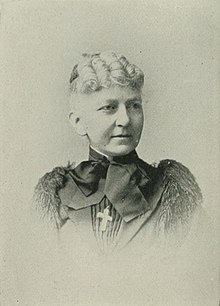Harriet McEwen Kimball

Harriet McEwen Kimball (November 2, 1834 - September 3, 1917) bụ onye America na-ede uri, onye na-ede ukwe, onye ọrụ ebere, na onye guzobere ụlọ ọgwụ. "Onye na-ede uri nke Chọọchị" dịka a na-akpọ ya ogologo oge, ndụ Kimball raara onwe ya nye akwụkwọ na ọrụ ụka. Ọ bụ otu n'ime ìgwè ndị na-ede uri nke narị afọ nke iri na itoolu nke Henry Wadsworth Longfellow bụ onye a ma ama na nke jere ozi nke ukwuu maka ịhụnanya America maka uri na ekele maka ya nke na ndị otu ahụ bụ n'echiche ụfọdụ ndị ọsụ ụzọ. Kimball bụ onye ikpeazụ n'ime ìgwè ahụ dị ndụ.
Mbido ndụ na agụmakwụkwọ
[dezie | dezie ebe o si]A mụrụ Harriet McEwen Kimball na Portsmouth, New Hampshire, na Nọvemba 2, 1834. Ọ bụ nwa nwanyị nke Dr. David Kimball na Caroline Rebecca Swett . [1] Ọ bụ nwatakịrị dị nro, a na-enyekwa ya agụmakwụkwọ n'ụlọ ya, ọkachasị site n'aka nne ya gụrụ akwụkwọ. Kimball malitere ide ihe mgbe ọ dị obere, ndị mụrụ ya katọrọ ọrụ ya, bụ ndị gbara ya ume ịzụlite ma jiri onyinye uri ya mee ihe.
Ọrụ
[dezie | dezie ebe o si]Kimball nwere mmasị n'ọrụ ebere n'oge ndụ ya niile, ụlọ ọgwụ Portsmouth Cottage Hospital bụ otu n'ime ihe ncheta na-agba akaebe maka ọrụ ebere ya. Ọ bụ onye òtù ụka na-arụsi ọrụ ike.
N'ọrụ edemede ya niile, ọ kpachapụrụ anya ma jiri nlezianya mee ihe. E bipụtara mpịakọta mbụ ya n'afọ 1867. N'afọ 1874, o bipụtara Swallow Flights of Song, na n'afọ 1879, The Blessed Company of All Faithful People. N'afọ 1889, e wepụtara uri ya n'ụdị zuru ezu. Ọtụtụ n'ime uri ya bụ nke okpukpe. Ọtụtụ n'ime ha bụ ukwe, a gụnyekwara ha na nchịkọta ụka niile nke ngwụcha narị afọ nke 19. Abụ nsọ ya bụ ihe nlereanya nke ụdị ha, a na-ewerekwa ọrụ ya dị iche na mpaghara ya siri ike. Ọ biri na Portsmouth, raara onwe ya nye ọrụ edemede ya, na mmasị okpukpe na ọrụ ebere ya.
Ọ bụ onye dere Hymns, (Boston, 1866); Swallow Flights of Song, (1874). Abụ ya gụnyere: - Mgbe ụfọdụ n'ogo Tabor (Ekwukwe arid Joy), Dear Lord, naanị gị (Lent), Ọ dị mfe ikwu. (Ọrụ dị umeala n'obi), Anyị enweghị anya mmiri, Ị gaghị akpọnwụ (Mmetụta). Ọ pụtara na Poets of Portsmouth (1864), na Unitarian Hymns of the Spirit (1864), yana ndị ọzọ. E tinyere ọtụtụ n'ime uri Kimball na Robert Hall Baynes' The Illustrated Book of Sacred Poems . [1]
Ọ bụ enyi John Greenleaf Whittier. [1][1] Ọ nwụrụ na Septemba 3, 1917, n'ụlọ ya na Portsmouth, e lie ya na Harmony Grove Cemetery, n'otu obodo ahụ.
Ọrụ ndị a họọrọ
[dezie | dezie ebe o si]- Abụ Ọma (1866)
- Ụgbọelu nke Abụ (1874)
- Òtù Ndị Agọzi nke Ndị Ikwesị Ike n'Iwu (1879)
- Abụ (1889)
At this thy banquet lord of all
At times on tabors height Christ
Christ is risen
Dawn of dawn's the Easter day
Dag ood ended the
Dear lord to the alone
For easter day o lilies white
Glory is the highest
It is an easy th ing to say
I've heard them sing of earthly Bowers
Ihe odide
[dezie | dezie ebe o si]- ↑ Harriet McEwen Kimball (en-us). www.hymntime.com. Archived from the original on 26 July 2018. Retrieved on 26 July 2018.
- This article incorporates text from this source, which is in the public domain: .mw-parser-output cite.citation{font-style:inherit;word-wrap:break-word}.mw-parser-output .citation q{quotes:"\"""\"""'""'"}.mw-parser-output .citation:target{background-color:rgba(0,127,255,0.133)}.mw-parser-output .id-lock-free a,.mw-parser-output .citation .cs1-lock-free a{background:url("//upload.wikimedia.org/wikipedia/commons/6/65/Lock-green.svg")right 0.1em center/9px no-repeat}.mw-parser-output .id-lock-limited a,.mw-parser-output .id-lock-registration a,.mw-parser-output .citation .cs1-lock-limited a,.mw-parser-output .citation .cs1-lock-registration a{background:url("//upload.wikimedia.org/wikipedia/commons/d/d6/Lock-gray-alt-2.svg")right 0.1em center/9px no-repeat}.mw-parser-output .id-lock-subscription a,.mw-parser-output .citation .cs1-lock-subscription a{background:url("//upload.wikimedia.org/wikipedia/commons/a/aa/Lock-red-alt-2.svg")right 0.1em center/9px no-repeat}.mw-parser-output .cs1-ws-icon a{background:url("//upload.wikimedia.org/wikipedia/commons/4/4c/Wikisource-logo.svg")right 0.1em center/12px no-repeat}.mw-parser-output .cs1-code{color:inherit;background:inherit;border:none;padding:inherit}.mw-parser-output .cs1-hidden-error{display:none;color:#d33}.mw-parser-output .cs1-visible-error{color:#d33}.mw-parser-output .cs1-maint{display:none;color:#3a3;margin-left:0.3em}.mw-parser-output .cs1-format{font-size:95%}.mw-parser-output .cs1-kern-left{padding-left:0.2em}.mw-parser-output .cs1-kern-right{padding-right:0.2em}.mw-parser-output .citation .mw-selflink{font-weight:inherit}[Ihe e dere n'ala ala peeji]A Dictionary of Hymnology: Setting Forth the Origin and History of Christian Hymns of All Ages and Nations (Public domain ed.Ọpụpụ ọzọC. Scribner's Sons.
- This article incorporates text from this source, which is in the public domain: .mw-parser-output cite.citation{font-style:inherit;word-wrap:break-word}.mw-parser-output .citation q{quotes:"\"""\"""'""'"}.mw-parser-output .citation:target{background-color:rgba(0,127,255,0.133)}.mw-parser-output .id-lock-free a,.mw-parser-output .citation .cs1-lock-free a{background:url("//upload.wikimedia.org/wikipedia/commons/6/65/Lock-green.svg")right 0.1em center/9px no-repeat}.mw-parser-output .id-lock-limited a,.mw-parser-output .id-lock-registration a,.mw-parser-output .citation .cs1-lock-limited a,.mw-parser-output .citation .cs1-lock-registration a{background:url("//upload.wikimedia.org/wikipedia/commons/d/d6/Lock-gray-alt-2.svg")right 0.1em center/9px no-repeat}.mw-parser-output .id-lock-subscription a,.mw-parser-output .citation .cs1-lock-subscription a{background:url("//upload.wikimedia.org/wikipedia/commons/a/aa/Lock-red-alt-2.svg")right 0.1em center/9px no-repeat}.mw-parser-output .cs1-ws-icon a{background:url("//upload.wikimedia.org/wikipedia/commons/4/4c/Wikisource-logo.svg")right 0.1em center/12px no-repeat}.mw-parser-output .cs1-code{color:inherit;background:inherit;border:none;padding:inherit}.mw-parser-output .cs1-hidden-error{display:none;color:#d33}.mw-parser-output .cs1-visible-error{color:#d33}.mw-parser-output .cs1-maint{display:none;color:#3a3;margin-left:0.3em}.mw-parser-output .cs1-format{font-size:95%}.mw-parser-output .cs1-kern-left{padding-left:0.2em}.mw-parser-output .cs1-kern-right{padding-right:0.2em}.mw-parser-output .citation .mw-selflink{font-weight:inherit}Morehouse-Gorham (1917)..Mpịakọta nke (Public domain ed.Ọpụpụ ọzọMorehouse-Gorham
- This article incorporates text from this source, which is in the public domain: .mw-parser-output cite.citation{font-style:inherit;word-wrap:break-word}.mw-parser-output .citation q{quotes:"\"""\"""'""'"}.mw-parser-output .citation:target{background-color:rgba(0,127,255,0.133)}.mw-parser-output .id-lock-free a,.mw-parser-output .citation .cs1-lock-free a{background:url("//upload.wikimedia.org/wikipedia/commons/6/65/Lock-green.svg")right 0.1em center/9px no-repeat}.mw-parser-output .id-lock-limited a,.mw-parser-output .id-lock-registration a,.mw-parser-output .citation .cs1-lock-limited a,.mw-parser-output .citation .cs1-lock-registration a{background:url("//upload.wikimedia.org/wikipedia/commons/d/d6/Lock-gray-alt-2.svg")right 0.1em center/9px no-repeat}.mw-parser-output .id-lock-subscription a,.mw-parser-output .citation .cs1-lock-subscription a{background:url("//upload.wikimedia.org/wikipedia/commons/a/aa/Lock-red-alt-2.svg")right 0.1em center/9px no-repeat}.mw-parser-output .cs1-ws-icon a{background:url("//upload.wikimedia.org/wikipedia/commons/4/4c/Wikisource-logo.svg")right 0.1em center/12px no-repeat}.mw-parser-output .cs1-code{color:inherit;background:inherit;border:none;padding:inherit}.mw-parser-output .cs1-hidden-error{display:none;color:#d33}.mw-parser-output .cs1-visible-error{color:#d33}.mw-parser-output .cs1-maint{display:none;color:#3a3;margin-left:0.3em}.mw-parser-output .cs1-format{font-size:95%}.mw-parser-output .cs1-kern-left{padding-left:0.2em}.mw-parser-output .cs1-kern-right{padding-right:0.2em}.mw-parser-output .citation .mw-selflink{font-weight:inherit}Willard, Frances Elizabeth; Livermore, Mary Ashton Rice (1893).A Woman of the Century: Iri na anọ Hundred-seventy Biographical Sketches Accompanied by Portraits of Leading American Women in All Walks of Life (Public domain ed.Ọpụpụ ọzọ[Ihe e dere n'ala ala peeji]
